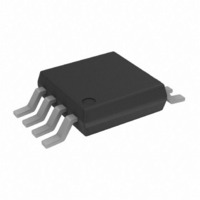AD8220ARMZ Analog Devices Inc, AD8220ARMZ Datasheet - Page 22

AD8220ARMZ
Manufacturer Part Number
AD8220ARMZ
Description
IC AMP INST JFET R-R 15MA 8MSOP
Manufacturer
Analog Devices Inc
Type
Instrumentation Ampr
Datasheet
1.AD8220-EVALZ.pdf
(28 pages)
Specifications of AD8220ARMZ
Design Resources
Fully Isolated Input Module Based on AD7793, ADuM5401, and a High Performance In-Amp (CN0067)
Amplifier Type
Instrumentation
Number Of Circuits
1
Output Type
Rail-to-Rail
Slew Rate
2 V/µs
-3db Bandwidth
1.5MHz
Current - Input Bias
25pA
Voltage - Input Offset
250µV
Current - Supply
750µA
Current - Output / Channel
15mA
Voltage - Supply, Single/dual (±)
4.5 V ~ 36 V, ±2.25 V ~ 18 V
Operating Temperature
-40°C ~ 85°C
Mounting Type
Surface Mount
Package / Case
8-MSOP, Micro8™, 8-uMAX, 8-uSOP,
Number Of Channels
1
Number Of Elements
1
Power Supply Requirement
Single/Dual
Common Mode Rejection Ratio
74dB
Voltage Gain Db
60dB
Input Offset Voltage
0.3@±5VmV
Input Bias Current
0.000025@5VnA
Single Supply Voltage (typ)
5/9/12/15/18/24/28V
Rail/rail I/o Type
Rail to Rail Output
Single Supply Voltage (min)
4.5V
Single Supply Voltage (max)
36V
Dual Supply Voltage (min)
±2.25V
Dual Supply Voltage (max)
±18V
Operating Temp Range
-40C to 85C
Operating Temperature Classification
Industrial
Mounting
Surface Mount
Pin Count
8
Package Type
MSOP
No. Of Amplifiers
1
Bandwidth
1.5MHz
Amplifier Output
Differential
Cmrr
84dB
Supply Voltage Range
± 2.25V To ± 18V
Supply Current
750µA
Rohs Compliant
Yes
Gain Db Min
1dB
Lead Free Status / RoHS Status
Lead free / RoHS Compliant
For Use With
AD8220-EVALZ - BOARD EVAL FOR AD8220ARMZ
Gain Bandwidth Product
-
Lead Free Status / RoHS Status
Compliant, Lead free / RoHS Compliant
Available stocks
Company
Part Number
Manufacturer
Quantity
Price
Part Number:
AD8220ARMZ
Manufacturer:
ADI/亚德诺
Quantity:
20 000
Part Number:
AD8220ARMZ-R7
Manufacturer:
ADI原装
Quantity:
20 000
Part Number:
AD8220ARMZ-REEL7
Manufacturer:
ADI/亚德诺
Quantity:
20 000
AD8220
RF INTERFERENCE
RF rectification is often a problem in applications where there are
large RF signals. The problem appears as a small dc offset voltage.
The AD8220 by its nature has a 5 pF gate capacitance, C
inputs. Matched series resistors form a natural low-pass filter that
reduces rectification at high frequency (see Figure 61). The
relationship between external, matched series resistors and the
internal gate capacitance is expressed as follows:
To eliminate high frequency common-mode signals while using
smaller source resistors, a low-pass RC network can be placed at
the input of the instrumentation amplifier (see Figure 62). The
filter limits the input signal bandwidth according to the following
relationship:
Mismatched C
The imbalance causes the AD8220 to treat what would have
been a common-mode signal as a differential signal. To reduce
the effect of mismatched external C
C
frequency lower than the common-mode frequency.
D
greater than 10 times C
FilterFreq
FilterFreq
FilterFreq
FilterFreq
Figure 61. RFI Filtering Without External Capacitors
C
CM
CM
DIFF
DIFF
capacitors result in mismatched low-pass filters.
R
R
π 2
π 2
π 2
π 2
0.1µF
0.1µF
RC
R
1
RC
+IN
R
–IN
1
(
C
2 (
G
1
C
C
G
. This sets the differential filter
C
–V
D
C
+15V
S
–15V
1
G
C
C
–V
)
G
C
G
S
C
AD8220
C
capacitors, select a value of
C
10µF
10µF
G
REF
)
V
OUT
G
, at its
Rev. B | Page 22 of 28
COMMON-MODE INPUT VOLTAGE RANGE
The common-mode input voltage range is a function of the
input range and the outputs of Internal Amplifier A1, Internal
Amplifier A2, and Internal Amplifier A3, the reference voltage,
and the gain. Figure 27 to Figure 30 show common-mode
voltage ranges for various supply voltages and gains.
DRIVING AN ADC
An instrumentation amplifier is often used in front of an ADC
to provide CMRR and additional conditioning, such as a voltage
level shift and gain (see Figure 63). In this example, a 2.7 nF
capacitor and a 1 kΩ resistor create an antialiasing filter for the
AD7685. The 2.7 nF capacitor also serves to store and deliver
the necessary charge to the switched capacitor input of the
ADC. The 1 kΩ series resistor reduces the burden of the 2.7 nF
load from the amplifier. However, large source impedance in
front of the ADC can degrade THD.
The example shown in Figure 63 is for sub-60 kHz applications.
For higher bandwidth applications where THD is important,
the series resistor needs to be small. At worst, a small series
resistor can load the AD8220, potentially causing the output to
overshoot or ring. In such cases, a buffer amplifier, such as the
AD8615, should be used after the AD8220 to drive the ADC.
±50mV
10µF
Figure 63. Driving an ADC in a Low Frequency Application
1.07kΩ
4.02kΩ
4.02kΩ
R
R
0.1µF
+IN
–IN
C
C
C
C
D
C
AD8220
+5V
Figure 62. RFI Suppression
1nF
10nF
1nF
REF
+2.5V
0.1µF
0.1µF
+IN
–IN
1kΩ
2.7nF
+15V
AD8220
–15V
REF
10µF
10µF
AD7685
V
OUT
ADR435
+5V
4.7µF












